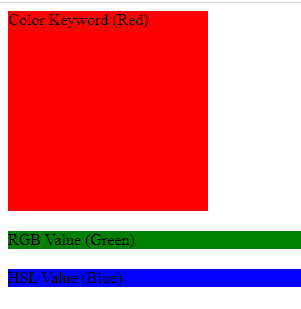CSS Background Colors
What are the Background Colors in CSS?
With the help of the CSS background colors property, we can set the element's background colors. It is also used in div, p, and body tags to change the background color of an element in an HTML document.
In CSS, we have different types of ways in which we can define the background color of an element. An HSL value, RGB value, colors keyword, or hexadecimal colors code can all be used to specify the background colors.
Example
Let's take an example showing how to use various background colors formant in HTML and CSS, including keywords, RGB, and HSL values.
Output:

Three elements in this illustration each have a unique background color.
- The colors keyword red is used to set the background colors of the first element, which has a class called my-div.
- The background colors of the second element, which has the class rgb-div, are set using the RGB value rgb(0, 128, 0), which denotes a shade of green.
- The background colors of the third are set using the HSL value hsl(240, 100%, 50%), which denotes a blue shade. It has the class name hsl-div.
Each element is styled with a 200-pixel width, 200-pixel height, and a 20-pixel bottom margin to create some separation between them.
Why We Use Background Color in CSS?
The background-color property in CSS is used to change an element's background colors. Listed below are a few justifications for using the background-color property in CSS:
- Visual styling: With the help of background color, we can improve the website's or any application's visuals to make it stand out. Using various background colors, we can add contrast, highlight significant elements, or establish a website theme.
- Readability and Accessibility: with the help of CSS background color, we can increase the readability of a text or content so the user can easily read the content inside an element. We can make the text easy to read for all the users using the background color property that improves the visuals of our website so users can enjoy and read easily.
- Consistency in Branding and Design: In CSS, with the help of background color, we can keep our website branding and design in an attractive format so can people will use our website more. You can establish a consistent visual identity across your website or application by choosing specific background colors with your brand's color palette.
- User Interaction and Feedback: Background colors can give users visual feedback or let them know how an element is doing. We can alter a button background color which means when a user clicks or hover over a button, its changes the color of that button. In other words, it makes the button interactive and responsive.
- Separating Content and Improving Layout: You can visually separate and organize content by giving different background colors to different elements or sections of your layout. Background colors can highlight particular sections, delineate the boundaries of elements, or establish a visual hierarchy within your page layout.
- Theming and personalization: Background colors can be used to create various themes or to give users the option of customizing how a website or application looks. With the help of background color, we can give the user a customized experience if we give them the option to change the background color to their unique preferences.
Limitation of Background Color
The CSS background-color property offers different options for changing an element's color. But some limitations are as follows:
- Browser support: All browsers may not support the full range of color formats and properties. Confirming that the specific CSS properties and values you intend to use are compatible with the target browsers is crucial, especially if you're going after less common or older browsers.
- Limited Transparency Options: CSS does not have built-in support for partial transparency levels, but you can set a transparent background color using transparent or rgba (0, 0, 0, 0). Additional strategies are necessary to achieve semi-transparent backgrounds, such as CSS opacity or CSS background images with transparency.
- Elements That Overlap: When elements overlap, the top element's background color may hide the underlying elements' backgrounds. This may affect the desired visual effect or lessen the visibility of the underlying content. To achieve the desired appearance in such circumstances, you might need to modify the positioning or stacking order of the elements or use CSS properties like opacity or z-index.
|

 For Videos Join Our Youtube Channel: Join Now
For Videos Join Our Youtube Channel: Join Now









